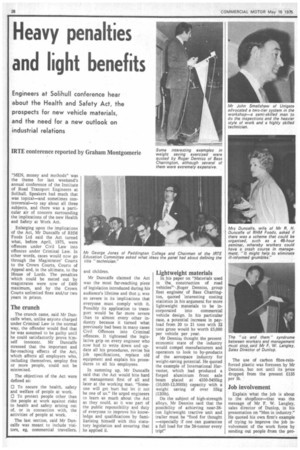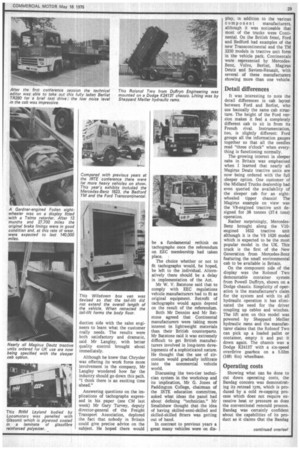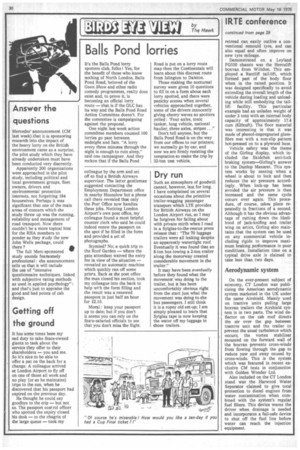Heavy penalties and light benefits
Page 30

Page 31

Page 32

If you've noticed an error in this article please click here to report it so we can fix it.
Engineers at Solihull conference hear about the Health and Safety Act, the prospects for new vehicle materials, and the need for a new outlook on industrial relations IRTE corn erence reported by Graham Montgomerie
"MEN, money and methods" was the theme for last weekend's annual conference of the Institute of Road Transport Engineers at Solihull. Speakers had much that was topical—and sometimes controversial—to say about all three subjects, and there was a particular air of concern surrounding the implications of the new Health and Safety at Work Act.
Enlarging upon the implications of the Act, Mr Duncalfe of RHM Foods Ltd said the Act turned what, before April, 1975, were offences under Civil Law into offences under Criminal Law. In other words, cases would now go through the Magistrates' Courts to the Crown Courts, Courts of Appeal and, in the ultimate, to the House of Lords. The penalties which could be meted out by magistrates were now of £400 maximum, and by the Crown Courts unlimited fines and/or two years in prison.
The crunch
The crunch came, said Mr Duncalfe when, unlike anyone charged under Criminal Law in the normal way, the offender would find that he was assumed to be guilty until he could satisfactorily prove h:mself innocent. Mr Duncalfe stressed that the important and far-reaching effects of the Act, which affects all employers who, including themselves, employ five or more people, could not be minimised.
The objectives of the Act were defined as: El To secure the health, safety and welfare of people at work.
0 To protect people other than the people at work against risks to health and safety arising out of, or in connection w:th, the activities of people at work.
The last section, said Mr Duncalfe was meant to include visitors, eg, commercial travellers, and children.
Mr Duncalfe claimed the Act was the most far-reaching piece of legislation introduced during his audience's lifetime and that was so severe in its implications that everyone must comply with it. Possibly its application to transport would be far more severe than to almost every other industry because it turned what previously had been in many cases Civil Offences into Criminal offences, It tightened the legislative grip on every engineer who now had to write dawn and update all his procedures, revise his job specifications, replace old equipment and explain his procedures to all his employees.
In summing up, Mr Duncalfe said that the Act would bite hard at management first of all and later at the working man. "Someone will get hurt but let it not be one of us." He urged engineers to learn as much about the Act as they could, as it was part of the public reponsibility and duty of everyone to improve his knowledge and qualifications by familiarising himself with this statutory legislation and ensuring that he applied it.
Lightweight materials
In his paper on "Materials used in the construction of road vehicles'"--.Roger Denniss, group fleet enginetkr, of Bass Charrington, quoted interesting casting statistics in his argument for more lightweight materials to be in corporated into commercial vehicle design. In his particular case, a potential increase in payload from 20 to 21 tons with 32 tons gross would be worth £5,000 per vehicle per year.
Mr Denniss thought the present economic state of the industry would compel manufacturers and operators to look to by-products of the aerospace industry for weight-saving potential. He quoted the example of International Harvester, which had produced a forged aluminium front axle beam plated at 4550-5450kg (10,000-12,000lb) capacity with a weight saving of over 55kg (1201b).
On the subject of high-strength alloys, Mr Denniss said that the possibility of achieving near-38ton lightweight tractive unit and trailer must be "food for thought —especially if one can guarantee a full load for the 38-tonner every trip!" The use of carbon fibre-reinforced plastic was foreseen by Mr Denniss, but not until its price dropped from the present £135 per lb.
Job involvement
Explain what the job is about to the shopfloor—that was the message of Mr F. W. Langley, sales director of Dunlop, in his presentation on "Men in industry." He quoted his own firm's example of trying to improve the job involvement of the work force by sending out people from the pro.
duction side with the sales engineers to learn what the customer really needs. The results were both satisfactory and dramatic, said Mr Langley, with better quality control brought about immediately.
Although he knew that Chrysler was offering its work force more involvement in the company, Mr Langley wondered how far the industry should go down this path. "I think there is an exciting time ahead."
Answering questions on the implications of tachographs expressed in his paper (see CM last week) Mr Gary Turvey, deputy director-general of the Freight Transport Association, deplored the fact that nobody in Britain could give precise advice on the subject. He hoped there would be a fundamental rethink on tachographs once the referendum on EEC membership had taken place.
The choice whether or not to fit tachographs would, he hoped, be left to the individual. Alternatively there should be a delay in implementation of the Act.
Mr W. V. Batstone said that to comply with EEC regulations vehicle manufacturers had to fit as original equipment. Retrofit of tachographs would again depend on the result of the referendum.
Both Mr Denniss and Mr Batstone agreed that Continental manufacturers were taking more interest in lightweight materials than their British counterparts. Mr Batstone said it was extremely difficult to get British manufacturers involved in long-term developments of a sophisticated nature. He thought that the use of zirconium would gradually infiltrate into the commercial vehicle world.
Discussing the two-tier technician system in the workshop and its implication, Mr G. Jones of Paddington College, chairman of the IRTE education committee, asked what ideas the panel had about defining "technician." Mr Smallshaw thought that the idea of having skilled-semi-skilled and skilled-skilled fitters was getting out of hand.
In contrast to previous years a great many vehicles were on dis play, in addition to the various component manufacturers, although it was noticeable that most of the trucks were Continental. On the British front, Ford and Bedford had examples of the new Transcontinental and the TM 3250 models in tractive unit form in the vehicle park. Continentals were represented by MercedesBenz, Volvo, Berliet, Magirus Deutz and Saviem-Renault, with several of these manufacturers showing more than one vehicle.
Detail differences
It was interesting to note the detail differences in cab layout between Ford and Berliet, who use basically the same cab structure. The height of the Ford version makes it feel a completely different cab to sit in from its French rival. Instrumentation, too, is slightly different: Ford groups all the information gauges together so that all the needles read "three o'clock" when everything is functioning normally.
The growing interest in sleeper cabs in Britain was emphasised when I learned that nearly all Magirus Deutz tractive units are now being ordered with the full sleeper option. One customer of the Midland Trucks dealership had even queried the availability of the sleeper cab for an eightwheeled tipper chassis! The Magirus example on view was the V8-engined tractive unit designed for 38 tonnes (37.4 tons) operation.
Rather surprisingly, MercedesBenz brought along the V10engined 1632 tractive unit although it is the V8 1626 model which is expected to be the most popular model in the UK. This truck is the first of the New Generation from Mercedes-Benz featuring the small environmental cab to be available in Britain.
On •the component side of the display was the Rolonof Two demountable container system from Powell Duffryn, shown on a Dodge chassis. Simplicity of operation is the manufacturer's claim for the system and with its all hydraulic operation it has eliminated the need for the driver coupling up cables and winches. The lift arm on this model was powered by Sheppard Meiller hydraulic rams and the manufacturer claims that the Rolonof Two can pick up a loaded pallet or container, empty it and put it down again. The chassis was a Dodge K2413T with a six-speed overdrive gearbox on a 5.03m (16ft Gin) wheelbase.
Operating costs
Showing what can be done to cut down operating costs, the Bandag concern was demonstrating its retread tyre, which is produced by a cold re-capping process which does not require excessive heat or pressure as does the conventional remould process. Bandag was certainly confident about the capabilities of its product as it claims that the Bandag
retread can easily outlive a conventional remould tyre, and can also equal and often improve on new tyre mileage.
Demonstrated on a Leyland FG550 chassis was the Herculift boxvan from Witsdon. This employed a Ratcliff tail-lift, which formed part of the body floor when in the raised position. It was designed specifically to avoid extending the overall length of the vehicle during loading and unloading while still embodying the taillift facility. This particular example had an unladen weight of under 3 tons with an internal body capacity of approximately 17.4 cum (620cuft). The floor material was interesting in that it was made of phenol-impregnated glassfibre mat with a non-slip pattern hot-pressed on to a plywood base.
Vehicle safety was the theme of the Girling display, which included the Skidchek anti-lock braking system—Girling's answer to the Dunlop Maxaret. This system works by sensing when a wheel is about to lock and then reduces the air pressure accordingly. When lock-up has been avoided the air pressure is then increased and the same cycle oocurs over again. This procedure, of course, takes place repeatedly in fractions of a second. Although it has the obvious advantage of cutting down the likelihood of jack-knifing and trailer wing on artics, Girling also maintains that the system can be used on any commercial vehicle including rigids to improve maximum braking performance in poor conditions. Installation time on a typical drive axle is claimed to take Less than two days,
Aerodynamic system
On the ever-present subject of economy, CT London was publicising the American aerodynamic system marketed in the UK under the name Airshield. Mainly used on tractive units pulling large boxvan trailers the Airshield system is in two parts. The wind deflector on the cab roof directs the air over the gap between tractive unit and the trailer to prevent the usual turbulence which occurs; the vortex stabiliser mounted on the forward wall of the .boxvan prevents cross-winds from flowing through the gap to reduce yaw and sway caused by cross-winds. This is the system which was featured in recent exclusive CM tests in conjunction with Golden Wander Ltd.
Also included on the CT London stand was the Harwood Water Separator claimed to give total protection to diesel engines from water contamination When combined with the system's regular fuel filters. This device warns the driver when drainage is needed and incorporates a fail-safe device to shut off the fuel line before water can reach the injection equipment.




























































































